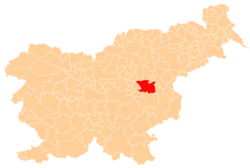Olešče
Olešče (pronounced [ɔˈleːʃtʃɛ]) is a settlement in the Municipality of Laško in eastern Slovenia. It lies in the hills east of Laško. The area was traditionally part of the Styria region. It is now included with the rest of the municipality in the Savinja Statistical Region.[2]
Olešče Sveti Peter pri Jurkloštru (until 1959), Šempeter (locally) | |
|---|---|
 Olešče Location in Slovenia | |
| Coordinates: 46°9′14.66″N 15°18′21.35″E | |
| Country | |
| Traditional region | Styria |
| Statistical region | Savinja |
| Municipality | Laško |
| Area | |
| • Total | 5.61 km2 (2.17 sq mi) |
| Elevation | 406.1 m (1,332.3 ft) |
| Population (2002) | |
| • Total | 253 |
| [1] | |
Name
The name of the settlement was changed from Sveti Peter pri Jurkloštru (literally, 'Saint Peter near Jurklošter') to Olešče in 1959. The name was changed on the basis of the 1948 Law on Names of Settlements and Designations of Squares, Streets, and Buildings as part of efforts by Slovenia's postwar communist government to remove religious elements from toponyms.[3][4][5] The settlement is still locally known as Šempeter. The name Olešče was first attested in 1328 as Beleczicz (and as Wellesitsch in 1382 and Beleschicz in 1423). The name Olešče is derived from a plural demonym, *Velešiťane, based on a patronymic derived from the hypocorism *Velešь.[6] Before Olešče became the name of the entire settlement, the name used to refer to one of the hamlets in the settlement.[7]
Mass grave
Olešče is the site of a mass grave from the end of the Second World War. The Olešče Mass Grave (Slovene: Grobišče Olešče) is located about 300 meters (980 ft) north of the neighboring village of Reka. It measures 3 by 1.5 meters (9.8 by 4.9 ft) and lies between two apple trees, and it contains the remains of about 14 Ustaša soldiers that were shot in May 1945.[8]
Church
The local church, built on a small hill south of the settlement core, is dedicated to Saint Peter and belongs to the Parish of Sveti Rupert. It is a Gothic building that was restyled in the Baroque in the 17th century.[9]
References
- Statistical Office of the Republic of Slovenia
- Laško municipal site
- Spremembe naselij 1948–95. 1996. Database. Ljubljana: Geografski inštitut ZRC SAZU, DZS.
- Premk, F. 2004. Slovenska versko-krščanska terminologija v zemljepisnih imenih in spremembe za čas 1921–1967/68. Besedoslovne lastnosti slovenskega jezika: slovenska zemljepisna imena. Ljubljana: Slavistično društvo Slovenije, pp. 113–132.
- Urbanc, Mimi, & Matej Gabrovec. 2005. Krajevna imena: poligon za dokazovanje moči in odraz lokalne identitete. Geografski vestnik 77(2): 25–43.
- Snoj, Marko (2009). Etimološki slovar slovenskih zemljepisnih imen. Ljubljana: Modrijan. p. 290.
- Savnik, Roman, ed. 1976. Krajevni leksikon Slovenije, vol. 3. Ljubljana: Državna založba Slovenije. p. 192.
- Ferenc, Mitja (December 2009). "Grobišče Olešče". Geopedia (in Slovenian). Ljubljana: Služba za vojna grobišča, Ministrstvo za delo, družino in socialne zadeve. Retrieved April 27, 2020.
- Slovenian Ministry of Culture register of national heritage reference number ešd 3329
